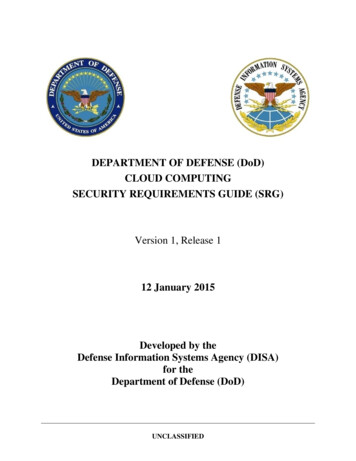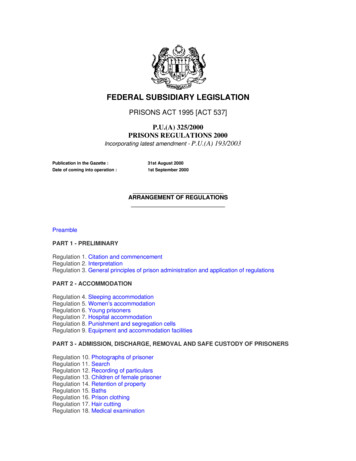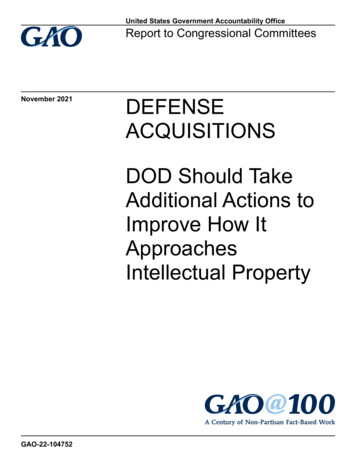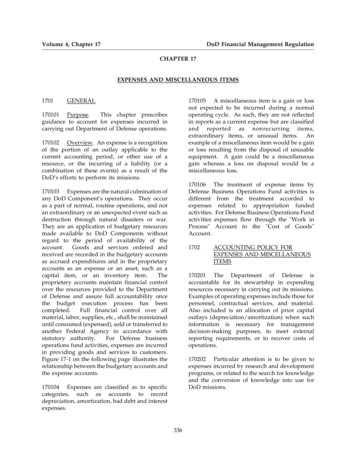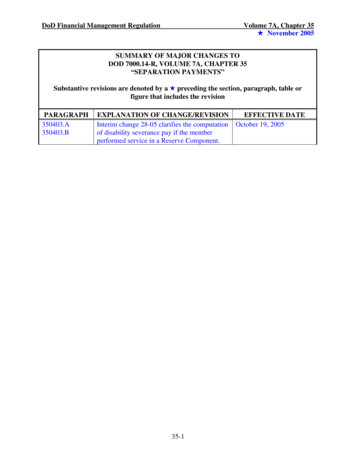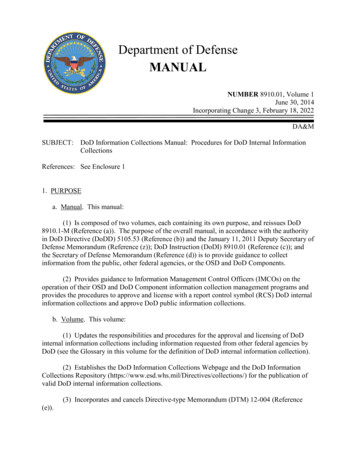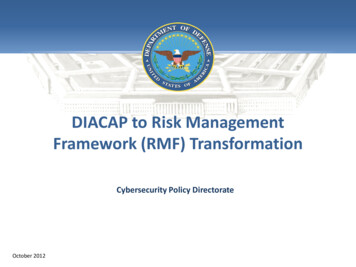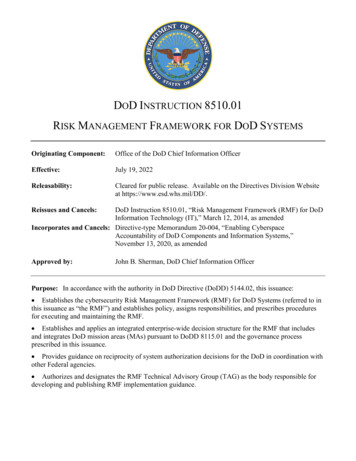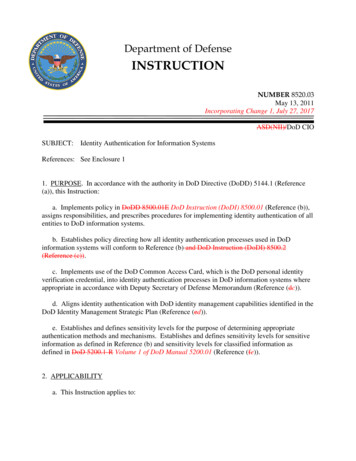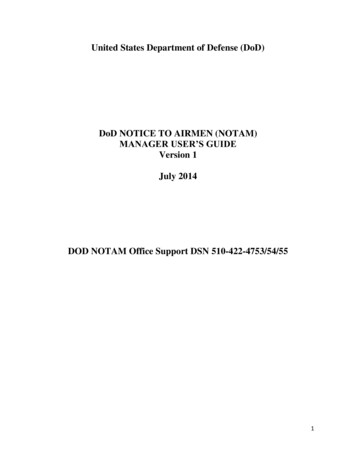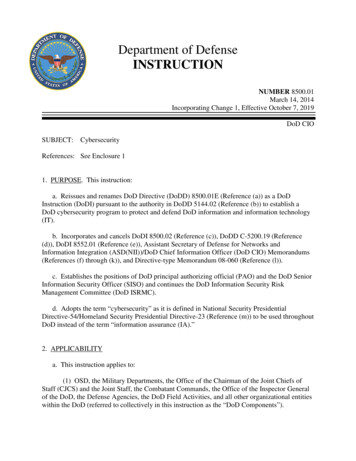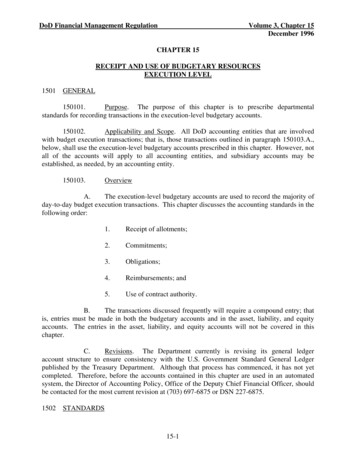
Transcription
DoD Financial Management RegulationVolume 3, Chapter 15December 1996CHAPTER 15RECEIPT AND USE OF BUDGETARY RESOURCESEXECUTION LEVEL1501GENERAL150101.Purpose. The purpose of this chapter is to prescribe departmentalstandards for recording transactions in the execution-level budgetary accounts.150102.Applicability and Scope. All DoD accounting entities that are involvedwith budget execution transactions; that is, those transactions outlined in paragraph 150103.A.,below, shall use the execution-level budgetary accounts prescribed in this chapter. However, notall of the accounts will apply to all accounting entities, and subsidiary accounts may beestablished, as needed, by an accounting entity.150103.OverviewA.The execution-level budgetary accounts are used to record the majority ofday-to-day budget execution transactions. This chapter discusses the accounting standards in thefollowing order:1.Receipt of ments; and5.Use of contract authority.B.The transactions discussed frequently will require a compound entry; thatis, entries must be made in both the budgetary accounts and in the asset, liability, and equityaccounts. The entries in the asset, liability, and equity accounts will not be covered in thischapter.C.Revisions. The Department currently is revising its general ledgeraccount structure to ensure consistency with the U.S. Government Standard General Ledgerpublished by the Treasury Department. Although that process has commenced, it has not yetcompleted. Therefore, before the accounts contained in this chapter are used in an automatedsystem, the Director of Accounting Policy, Office of the Deputy Chief Financial Officer, shouldbe contacted for the most current revision at (703) 697-6875 or DSN 227-6875.1502STANDARDS15-1
DoD Financial Management Regulation150201.A.Volume 3, Chapter 15December 1996Allotments ReceivedRequirements1.An allotment is a distribution of budget authority to an execution level accounting entity. It authorizes the incurrence of obligations within a specified amount.Suballotments may be used to further subdivide the budget authority. As accounting for asuballotment is the same as accounting for an allotment, only the term allotment will be used inthis chapter.2.Although an allotment document format is not prescribed, it mustdisclose specific classifications and limitations that must be tracked in the accounting records.For instance, an appropriation committee may state that a specific amount has been added to anappropriation for a certain purpose. To ensure that the congressional intent is accomplished, theaccounting entity receiving an allotted share of such budget authority shall account for it, and forthe undelivered orders and accrued expenditures incurred against that share.B.Accounting Entries1.GLA 4580, “Allotments Received,” (figure 15-41) is used torecord allotments of direct program authority received by an execution-level accounting entity.2.Allotments of Appropriated Authority. If an allotment documentprovides the basis, the credits shall be segregated among the accounts established for the currentperiod, subsequent periods, and withheld amounts (pending completion of action necessary forrelease). Figures 15-41 through 15-47 define the accounts used to classify uncommitted/unobligated allotments, and illustrate the entries for transactions affecting them. The generalledger accounting entry for recording receipt of an allotment of appropriated (direct program)authority follows:a.Allotment Immediately Available for ObligationDr 4580 Allotments ReceivedCr 4611 Uncommitted/Unobligated ObligationAuthority - Direct Program-Availableb.Allotment Not Immediately Available for ObligationDr 4580 Allotments ReceivedCr 4591 Uncommitted/Unobligated Obligation AuthorityAvailable in Subsequent PeriodsCr 4592 Uncommitted/Unobligated Obligation AuthorityAvailability Withheld15-2
DoD Financial Management Regulation150202.A.Volume 3, Chapter 15December 1996CommitmentsRequirements1.A commitment is an administrative reservation of funds basedupon firm procurement requests, orders, directives, and equivalent instruments. Since anobligation equal to or less than the commitment may be incurred without further recourse to anauthorizing official, commitments are required for some appropriations (see subparagraph150202.A.5) and are permissible for others. Commitments, when recorded in the accountingrecords, reduce the uncommitted/unobligated balance. A commitment document shall be signedby a person authorized to reserve funds; that is, the official responsible for administrative controlof funds for the affected subdivision of the appropriation. This helps ensure that the subsequententry of an undelivered order or accrued expenditure will not exceed available funds.2.Chapter 8 of this volume contains the detailed requirements forestimating and recording the amounts of commitments.3.A commitment generally is not recordable from an actiondocument approving a procurement program because execution of the program requires specificactions to reserve all or part of the subdivision of funds made available to the program. Theprogram approval may be recorded as an initiation. (See subparagraph 150202.A.4., below.)Also, a commitment usually is not recordable from an order to commence procurement sincesuch orders generally are not firm reservations permitting the recording of an obligation withoutrecourse to the person authorized to reserve funds. Such orders also may be recorded asinitiations.4.Initiations are entered into memorandum accounts to ensure thatprecommitment actions, such as approved procurement programs and procurement orders, aremaintained within the available subdivision of funds. An initiation results in an administrativereservation of funds based upon procurement orders, requests, or equivalent instruments. Itauthorizes preliminary negotiation of procurement actions, but requires that the action must bereferred to the official responsible for administrative control of funds prior to incurrence of theobligation. Since initiations are not part of the official accounting requirements, allotmentissuers or receivers who require initiation accounting shall ensure that the procedures andpractices are cost effective. Synonyms for the term “initiation” may be used.5.Commitment accounting is required by agreement with the OMBfor the procurement appropriation accounts; military construction appropriation accounts; andthe research, development, test and evaluation appropriation accounts. However, commitmentsneed not be recorded for small purchases if, in the aggregate, they are not significant in themanagement of funds. Commitment accounting is not required for the operation andmaintenance appropriation accounts, revolving fund accounts, or the military personnelappropriation accounts, but may be used if cost effective.15-3
DoD Financial Management RegulationVolume 3, Chapter 15December 19966.Outstanding commitments shall be canceled as of the end of theperiod that the appropriation is available for obligation. There can be no commitments inexpired appropriation accounts.B.Accounting Entries1.Commitments are recorded as follows:Dr 4611 Uncommitted/Unobligated Allotments Direct Program - Current PeriodDr 4614 Uncommitted/Unobligated Allotments Reimbursable Program - Current PeriodCr 4710Outstanding Commitments - Direct ProgramCr 4720Outstanding Commitments - ReimbursableProgram2.Outstanding commitments are reduced when an undelivered orderor Expended Authority entry is made. The entry is as follows:Dr 4710 Outstanding Commitments - Direct ProgramDr 4720 Outstanding Commitments - Reimbursable ProgramCr 4811 Undelivered Orders - Unpaid - Direct ProgramCr 4812 Undelivered Orders - Paid - Direct ProgramCr 4821 Undelivered Orders - Unpaid - ReimbursableProgramCr 4822 Undelivered Orders - Paid - ReimbursableProgramCr 4910 Expended Authority-Unpaid - Direct ProgramCr 4920 Expended Authority-Unpaid - ReimbursableProgramCr 4931 Expended Authority-Paid - Direct ProgramCr 4941 Expended Authority-Paid - ReimbursableProgramDr/Cr 4611 Uncommitted/Unobligated Allotments - DirectProgram - Current PeriodCr 4614 Uncommitted/Unobligated Allotments Reimbursable Program - Current Period(GLAs 4611/4614 are increased [credited] or decreased [debited] if theundelivered order or accrued expenditure differs from the outstanding commitment.)3.Figures 15-51 through 15-53 define the outstanding commitmentaccounts and illustrate the effect of entries 1 and 2.150203.Obligations15-4
DoD Financial Management RegulationA.Volume 3, Chapter 15December 1996Requirements1.Obligations incurred are the amounts of orders placed, contractsawarded, services received, and similar transactions during an accounting period that will requirepayment during the same or a future period. Such amounts include payments for whichobligations have not previously been recorded, and adjustments for differences betweenobligations previously recorded and actual payments to liquidate those obligations.2.The execution-level budgetary account structure requires that theamount of obligations incurred be segregated into undelivered orders and Expended Authority Paid or Expended Authority - Unpaid. The Expended Authority - Paid is the definitive finalobligation incurred. It shall be recorded regardless of whether the preceding steps of ordering(undelivered order) and delivery (Expended Authority - Unpaid) were recorded. It is notnecessary for the order and delivery transaction to be recorded in the budgetary accounts afterthe fact.3.“Expended Authority” is the term used for the credits entered intothe budgetary accounts to recognize liabilities incurred and payments made for (a) servicesperformed by employees, contractors, other government accounting entities, vendors, carriers,grantees, lessors, etc.; (b) goods and other tangible property received; and (c) items such asannuities or insurance claims for which no current service is required. In the DoD execution level budgetary accounts, Expended Authority is categorized either as paid or unpaid. Entries tothe Expended Authority accounts require a compound entry to affect the asset, liability, andequity accounts. The asset, liability, and equity account entries are discussed in other parts ofthis Regulation.4.Undelivered orders are contracts or orders issued for goods andservices for which the liability has not yet accrued. The orders may be for any goods or servicesthat are required to meet a bona fide need of the issuing entity.5.Reductions or cancellations of prior year obligations in no-yearand unexpired multiple-year accounts shall be reported specifically in budget execution reports.(See Volume 6, Chapter 4 of this Regulation.) GLA 4310, “Anticipated Recoveries of PriorYear Obligations,” shall not be used without prior approval of the Directorate for AccountingPolicy, OUSD(C).6.Chapter 8 of this volume contains the detailed requirements fordetermining and recording the amounts of obligations.B.Accounting Entries. Obligations are recorded as follows:1.The entry to record an undelivered order (without an advancepayment) preceded by a commitment:15-5
DoD Financial Management RegulationVolume 3, Chapter 15December 1996Dr 4710 Outstanding Commitments - Direct ProgramCr 4811 Undelivered Orders - Unpaid - Direct ProgramDr/Cr 4611 Uncommitted/Unobligated Allotments - DirectProgram - Current PeriodDr 4720 Outstanding Commitments - Reimbursable ProgramCr 4821 Undelivered Orders - Unpaid - ReimbursableProgramDr/Cr 4614 Uncommitted/Unobligated Allotments Reimbursable Program - Current Period(GLAs 4611/4614 are increased [credited] or decreased [debited] if theundelivered order differs from the outstanding commitment.)2.The entry to record an undelivered order (without an advancepayment) not preceded by a commitment:Dr 4611 Uncommitted/Unobligated Allotments Direct Program - Current PeriodCr 4811 Undelivered Orders - Unpaid - Direct ProgramDr 4614 Uncommitted/Unobligated Allotments Reimbursable Program - Current PeriodCr 4821 Undelivered Orders - Unpaid Reimbursable Program3.The entry to record an undelivered order (with an advancepayment, such as a travel advance) not preceded by a commitment:Dr 4611 Uncommitted/Unobligated Allotments - Direct Program- Current PeriodCr 4812 Undelivered Orders - Paid - Direct Program(amount of advance)Cr 4811 Undelivered Orders - Unpaid - Direct Program(net obligation)Dr 4614 Uncommitted/Unobligated Allotments Reimbursable Program - Current PeriodCr 4822 Undelivered Orders - Paid – ReimbursableProgram (amount of advance)Cr 4821 Undelivered Orders - Unpaid Reimbursable Program (net obligation)NOTE: Entries to GLAs 4812 and 4822 require a compound entry to debit the GLA series 1400,“Advances and Prepayments,” and credit GLA 1012, “Funds Disbursed.”15-6
DoD Financial Management RegulationVolume 3, Chapter 15December 19964.The entry to recognize an Expended Authority-Unpaid for deliveryof goods or performance of services when an undelivered order-without advance has beenrecorded:Dr 4811 Undelivered Orders - Unpaid - Direct ProgramCr 4910 Expended Authority-Unpaid - Direct ProgramDr/Cr 4611 Uncommitted/Unobligated Allotments Direct Program - Current PeriodDr 4821 Undelivered Orders - Unpaid - Reimbursable ProgramCr 4920 Expended Authority-Unpaid - ReimbursableProgramDr/Cr 4614 Uncommitted/Unobligated Allotments Reimbursable Program - Current Period(GLAs 4611/4614 are increased [credited] or decreased [debited] ifthe Expended Authority-Unpaid differs from the undelivered order.)NOTE: Entries to GLAs 4910 and 4920 require a compound entry to credit the GLA series2000, “Liabilities,” and debit the GLA series 1000, “Assets,” or GLA series 6000, “Expense,” asappropriate.5.The entry to recognize Expended Authority-Unpaid when anundelivered order or commitment has not been recorded:Dr 4611 Uncommitted/Unobligated Allotments-Direct ProgramCurrent PeriodCr 4910 Expended Authority Unpaid - Direct ProgramDr 4614 Uncommitted/Unobligated Allotments - ReimbursableProgram - Current PeriodCr 4920 Expended Authority-Unpaid - ReimbursableProgramNOTE: Entries to GLAs 4910 and 4920 require a compound entry to credit the GLA series2000, “Liabilities,” and debit the GLA series 1000, “Assets,” or GLA series 6000, “Expense,” asappropriate.6.The entry to recognize Expended Authority-Paid when ExpendedAuthority-Unpaid has been recorded:Dr 4910 Expended Authority-Unpaid - Direct ProgramCr 4931 Expended Authority-Paid - Direct ProgramDr/Cr 4611 Uncommitted/Unobligated Allotments Direct Program Available15-7
DoD Financial Management RegulationVolume 3, Chapter 15December 1996Dr 4920 Expended Authority-Unpaid - Reimbursable ProgramCr 4941 Expended Authority-Paid - ReimbursableProgramDr/Cr 4614 Uncommitted/Unobligated Allotments Reimbursable Program(GLAs 4611/4614 are increased [credited] or decreased [debited] if theExpended Authority-Paid differs from the Expended Authority-Unpaid.)7.The entry to recognize Expended Authority-Paid when anUndelivered Order-Paid has been recorded:Dr 4812 Undelivered Orders - Paid - Direct ProgramCr 4931 Expended Authority-Paid - Direct ProgramDr 4822 Undelivered Orders - Paid - Reimbursable ProgramCr 4941 Expended Authority-Paid - ReimbursableProgramNOTE: Entries to GLAs 4931 and 4941 require a compound entry to debit GLA series 1400,“Advances and Prepayments,” and to credit GLA 1012, “Funds Disbursed.”8.The entry to recognize Expended Authority-Paid when ExpendedAuthority-Unpaid, an undelivered order, or commitment has not been recorded:Dr 4611 Uncommitted/Unobligated Allotments - DirectProgram - AvailableCr 4931 Expended Authority-Paid - Direct ProgramDr 4614 Uncommitted/Unobligated Allotments - ReimbursableProgramCr 4941 Expended Authority-Paid - ReimbursableProgramNOTE: Entries to GLAs 4931 and 4941 require a compound entry to debit GLA series 1000,“Assets,” or GLA series 6000, “Expense,” and to credit GLA 1012, “Funds Disbursed.”9.The entry to recognize a refund due of a previously made payment:Dr 4931 Expended Authority-Paid - Direct ProgramCr 4932 Expended Authority - Refunds Due Direct ProgramDr 4941 Expended Authority-Paid - Reimbursable Program15-8
DoD Financial Management RegulationVolume 3, Chapter 15December 1996Cr 4942 Expended Authority - Refunds Due Reimbursable ProgramNOTE: Entries to GLAs 4932 and 4942 require a compound entry to debit GLA, 1315,“Refunds Receivable - Government” or GLA 1316, “Refunds Receivable - Public” and to creditthe GLA series 1000, “Assets” or GLA series 6000, “Expense,” as appropriate.10.previously made payment:The entry to recognize the collection of a refund due of aDr 4932 Expended Authority - Refunds Due - Direct ProgramCr 4611 Uncommitted/Unobligated Allotments - DirectProgram - Current PeriodDr 4942 Expended Authority - Refunds Due - ReimbursableProgramCr 4614 Uncommitted/Unobligated Allotments Reimbursable Program - Current PeriodNOTE: Entries to GLAs 4932 and 4942 require a compound entry to debit GLA, 1011, “FundsCollected” and to credit the GLA 1315, “Refunds Receivable - Government” or GLA 1316,“Refunds Receivable - Public.”11.The entry to recognize disbursements reported by the TreasuryDepartment and departmental (or other) finance network that are not immediately distributable atthe execution level (such as, disbursements that fail local edit routines) is as follows:Dr 4910 Expended Authority-Unpaid - Direct ProgramDr 4920 Expended Authority-Unpaid - Reimbursable ProgramCr 4950 Expended Authority-Paid - UndistributedNOTE: Entries to GLA 4950 require a compound entry to debit GLA 1015,“Undistributed Disbursements,” and credit GLA 1012, “Funds Disbursed.”12.Undistributed disbursements shall be researched to identify theproper fund to which they apply. Erroneously reported disbursements shall be reversed. Theaccounting entry to record disbursements after their proper identification is known is as follows:Dr 4950 Expended Authority-Paid - UndistributedCr 4931 Expended Authority-Paid - Direct ProgramCr 4941 Expended Authority-Paid – ReimbursableProgram13.The entry to record recovery of a prior year direct programobligation in a no-year or unexpired multiple-year account is as follows:15-9
DoD Financial Management RegulationVolume 3, Chapter 15December 1996Dr 4811 Undelivered Orders - Unpaid - Direct ProgramDr 4910 Expended Authority-Unpaid - Direct ProgramCr 4971 Downward Adjustments of Prior Year ExpendedAuthority - UnpaidDr 4931 Expended Authority-Paid - Direct ProgramDr 4812 Undelivered Orders - Paid -Direct ProgramCr 4972 Downward Adjustments of Prior Year ExpendedAuthority - Paid14.The entry to record recovery of a prior year reimbursable programobligation in a no-year or unexpired multiple-year account is as follows:Dr 4821 Undelivered Orders - Unpaid - Reimbursable ProgramCr 4871 Downward Adjustments of Prior YearUndelivered Orders-UnpaidDr 4920 Expended Authority-Unpaid - Reimbursable ProgramCr 4971 Downward Adjustments of Prior Year ExpendedAuthority - UnpaidDr 4822 Undelivered Orders - Paid Reimbursable ProgramCr 4872 Downward Adjustments of Prior YearUndelivered Orders-PaidDr 4941 Expended Authority-Paid - Reimbursable ProgramCr 4972 Downward Adjustment of Prior Year ExpendedAuthority - Paid15.Figures 15-46 through 15-74 define the obligation accounts andillustrate the effects of entries (1) through Reimbursements to appropriations (appropriation reim bursements) are amounts earned and collected for property sold or services furnished either tothe public or another federal accounting entity. To be considered an appropriation reim bursement, the collection must be authorized by law for credit to the specific appropriation orfund account. Within the Department, a reimbursement program must be authorized for theaccount by the USD(C) through the budget preparation process and statutory authorization of the15-10
DoD Financial Management RegulationVolume 3, Chapter 15December 1996budget through the authorization and appropriation process. Except for refunds, collections thatare not authorized as appropriation reimbursements shall be deposited to the general fund of theU. S. Treasury as miscellaneous receipts. (Refunds normally are deposited to the appropriationaccount from which the original disbursement was made.)b.In general, collections in the absence of an authorizedreimbursable program for DoD goods and services do not create budgetary resources. Except forrefunds, such collections shall be deposited to the general fund of the U. S. Treasury asmiscellaneous receipts unless the deposit to an appropriation or fund is authorized by law.Volume 11A, Chapter 3 of this Regulation contains the general statement of policy andrequirements when work is performed or materiel is provided to private parties.2.Anticipated Reimbursementsa.Anticipated reimbursements are, in the case of transactionswith the public, estimated collections comprising advances expected to be received andreimbursements expected to be earned. In transactions between U.S. Government accountingentities, anticipated reimbursements consist of orders expected to be received, but for which noorders have been accepted. Anticipated reimbursements may not be used as a source ofobligational authority until a customer order is accepted unless such use specifically isauthorized in statute. The primary example of the use of anticipated reimbursements to createobligational authority is a revolving fund, in which anticipated reimbursements underlieapportionments of contract authority.b.An allotted reimbursable program does not constituteauthority to incur obligations. Obligations may be incurred only upon acceptance of a customerorder. The reimbursable program does not have to be specifically allotted. Apportionment,allocation, and allotment of the reimbursable program may be treated as “automatic” whenwritten OMB approval is obtained by the DoD Component responsible for the appropriationconcerned. OMB approval is dependent upon meeting the criteria for automatic apportionmentof reimbursements contained in Chapter 2 of this volume.3.Customer Ordersa.Accepted customer orders establish obligational authorityin a performing allotment. Unfilled customer orders are the amounts of orders accepted fromother accounting entities within the U.S. Government for goods and services to be furnished on areimbursable basis; or, in the case of transactions with the public, are amounts collected inadvance for which the accounting entity has not yet performed as requested. On an exceptionbasis, there may be orders from the public received and accepted without payment in advance,but only when specifically permitted by statute. Acceptance of a customer order requires that theperforming accounting entity agree in writing to perform the work for the requesting (customer)accounting entity. Volume 11A of this Regulation discusses the forms that are used to documentthese requests and acceptances. GLA 4221, “Unfilled Customer Orders - Unpaid - AutomaticApportionment,” GLA 4222, “Unfilled Customer Orders - Unpaid - Specific Apportionment,”15-11
DoD Financial Management RegulationVolume 3, Chapter 15December 1996GLA 4223, “Unfilled Customer Orders - Paid - Automatic Apportionment,” and GLA 4224,“Unfilled Customer Orders - Paid - Specific Apportionment,” are the execution-level budgetaryaccounts that are used, as applicable, to record obligational authority for the reimbursableprogram. Corresponding amounts are recorded in GLA 4614, “Uncommitted/UnobligatedAllotments - Reimbursable Program - Current Period.” An allotment of reimbursable programauthority, whether specific or automatic, authorizes the reimbursable program. It does notestablish obligational authority.b.In the case of multiple-year appropriation accounts whoseperiods of availability for obligation overlap, reimbursable customer orders and their relatedtransactions shall be applied only to the most current account available during the period theorders were received. In other words, new customer orders may not be recorded in a multiple year appropriation account after its first year of availability.4.Unearned Revenue. Unearned revenue is the amount recognizedas received by a performing organization in the form of advance payments for the future deliveryof goods, services, or other assets. GLA 4223, “Unfilled Customer Orders - Paid - AutomaticApportionment,” and GLA 4224, “Unfilled Customer Orders - Paid - Specific Apportionment,”are the execution-level budgetary accounts that are used as applicable to record reimbursableorders accepted with advance payment. Compound entries must be made to recognize advancepayments in both the budgetary accounts and asset and liability accounts. The proprietaryaccounting entries are illustrated in Volume 4, Chapter 13 of this Regulation. (See GLA 2300,“Unearned Revenues (Advances)”.)5.Earned Reimbursementsa.An earned reimbursement is the amount recognized when aperforming organization renders actual or constructive performance on a reimbursable order.Generally, it is at the point of recognition of an accrued expenditure--paid or unpaid--thatcompound entries must be made to record the performance and earnings in both the budgetaryaccounts and in the asset, liability, and equity accounts. However, reimbursable orders receivedand accepted with payment in advance require a compound entry to credit GLA 2300, “UnearnedRevenues (Advances),” and debit GLA 1011, “Funds Collected.” (See subparagraph 150204A.4., above.)b.Generally, reimbursements shall recover the cost elementsset forth in Volume 11A of this Regulation. However, other billing prices may be establishedwhen specifically authorized by a DoD issuance (e.g., directive or instruction). See Volume 11Afor additional guidance.c.Reimbursements shall be accounted for separately by theaccounting entity having responsibility for collection. Appropriate billing documents indicatingthe specific property delivered or services rendered, quantities, dollar amounts, and reference toeach customer order shall be maintained.15-12
DoD Financial Management RegulationVolume 3, Chapter 15December 1996d.Earned reimbursements shall be recorded and billedpromptly in the accounting period earned. However, see the waiver of billing of small amountsin Chapter 1, Volume 11A of this Regulation.e.Collections from DoD accounting entities generally shouldbe made without the use of checks through processing the billing and collecting entriessimultaneously in the disbursing officers’ accounts. The requesting accounting entity shallrecord its obligations in accordance with the standards for recognition of obligations inVolume 3, Chapter 8 of this Regulation.6.Sales from Inventory. For FMS and non-FMS sales of items frominventory, a determination first must be made whether the item requires replacement, that thereis a replacement-in-kind, or that it will not be replaced (free assets). FMS sales of free assetsshall be deposited in the U. S. Treasury as miscellaneous receipts, or in the Special DefenseAcquisition Fund. Earnings from all other sales from inventory (items requiring replacement,replacement-in-kind and non-FMS free assets) are available for obligation up to accountexpiration. Collections shall be made before obligations can be incurred for reprocurement. Ifthe item sold is to be replaced with an identical item (replacement-in-kind), the reimbursementfrom the sale shall be included in reimbursable financing, and the buy-back of the item in thereimbursable program. If the replacement will not be identical to the item sold, thereimbursement from the sale will be included under reimbursable financing, but the buy-back ofthe replacement shall be shown under the direct budget program and reprogramming action takenprior to replacement.B.Accounting Entries1.Allotments of Anticipated Reimbursable Program Authority. Atthe beginning of each fiscal year an entry shall be made to record an allotment of anticipatedreimbursable program authority. For an automatically apportioned reimbursable program (thepredominant type within the Department), an estimate of the expected reimbursable programshall be entered. For a specifically apportioned reimbursable program, the exact amountspecified in the allotment device shall be entered. An estimate of automatically apportionedreimbursable authority may be revised, upward or downward, by the performing activity at anytime during a fiscal year to reflect the current estimate. The specifically apportionedreimbursable program authority may not be revised unless a revised allotment device isrequested and received. The general ledger accounting entry for recording an allotment ofauthority to accept reimbursable orders is as follows:Dr 4210 Anticipated ReimbursementsCr 4593 Specifically Apportioned Reimbursable ProgramorCr 4594 Automatically Apportioned ReimbursableProgram15-13
DoD Financial Management RegulationVolume 3, Chapter 15December 1996NOTE: An allotment of anticipated reimbursable program authority does not provide obligationauthority. An allotment of anticipated reimbursable program authority provides only authority toaccept reimbursable orders. The accepted reimbursable order provides the obligation authority.2.Acceptance of Customer Ordersa.Specifically Apportioned Reimbursable Program.entry for acceptance of a customer order under specific apportionment is as follows:TheDr 4593 Specifically Apportioned Reimbursable ProgramCr 4614 Uncommitted/Unobligated Allotments Reimbursable ProgramDr 4221 Unfilled Customer Orders - UnpaidorDr 4222 Unfilled Customer Orders - PaidCr 4210 Anticipated Reimbursementsb.Automatically Apportioned Reimbursable Program. Theentry for acceptance of a customer order when automatic apportionment is approved is asfollows:Dr 4594 Automatically Apportioned Reimbursable ProgramCr 4614 Uncommitted/Unobliga
DoD Financial Management Regulation Volume 3, Chapter 15 December 1996 150201. Allotments Received A. Requirements 1. An allotment is a distribution of budget authority to an execution level accounting entity. It authorizes the incurrence of obligations within a specified amount. Suballotments may be used to further subdivide the budget .
